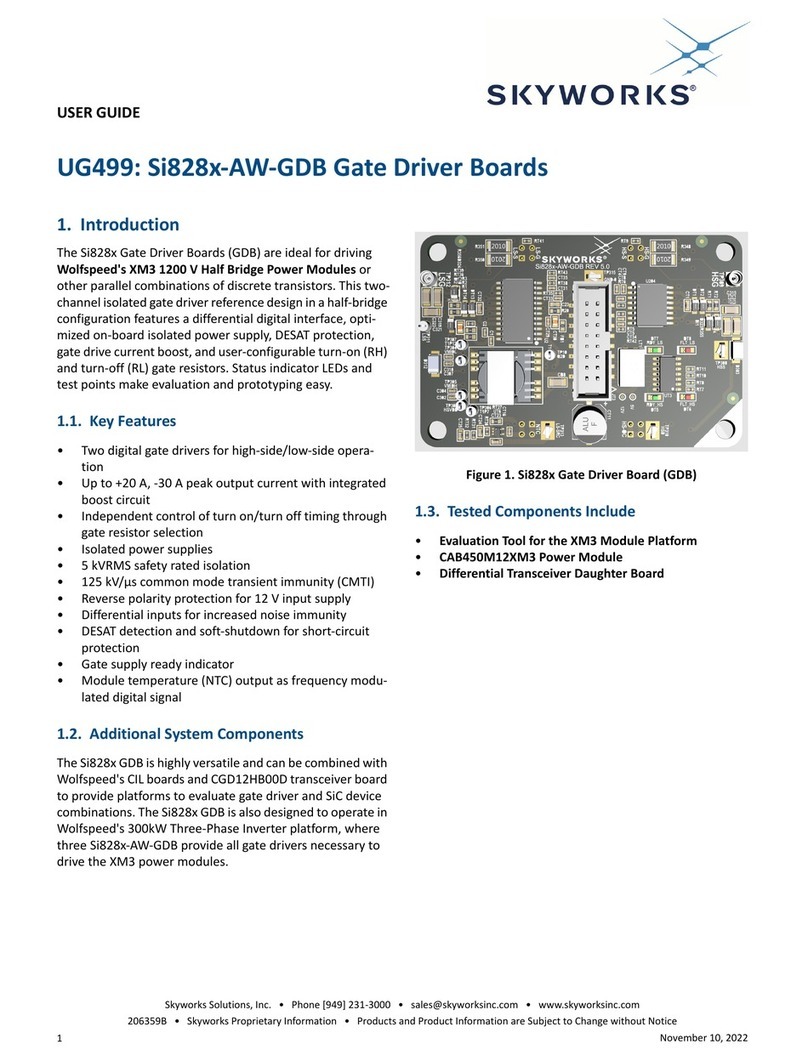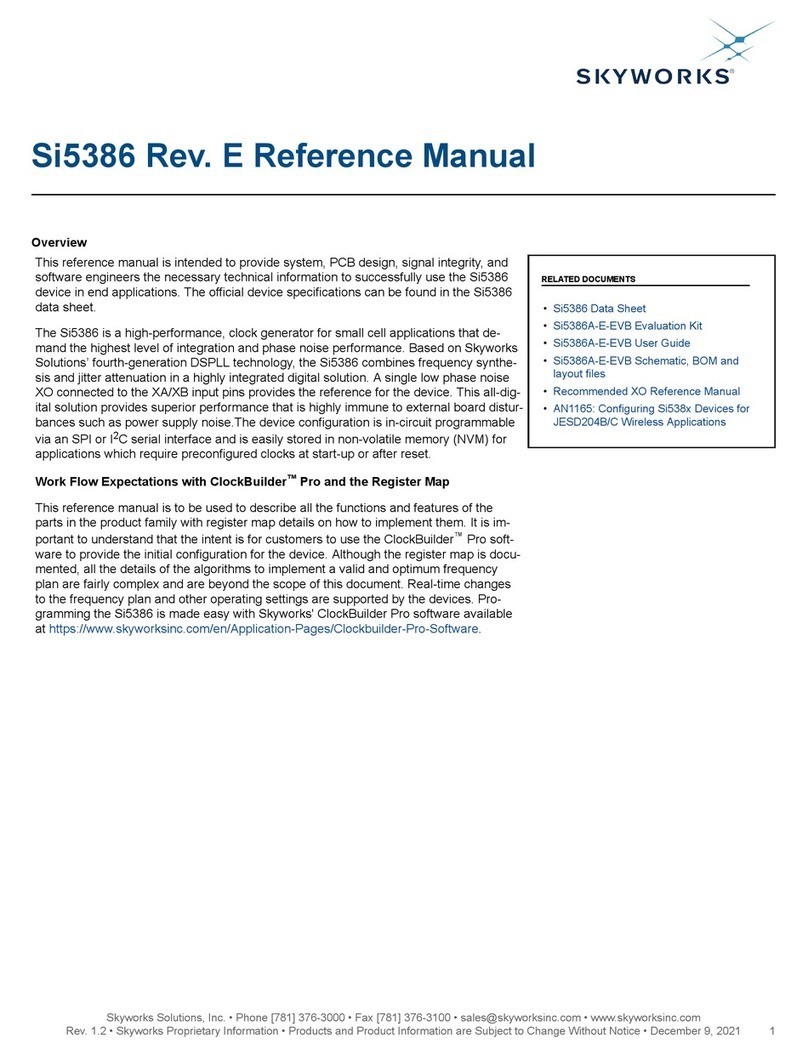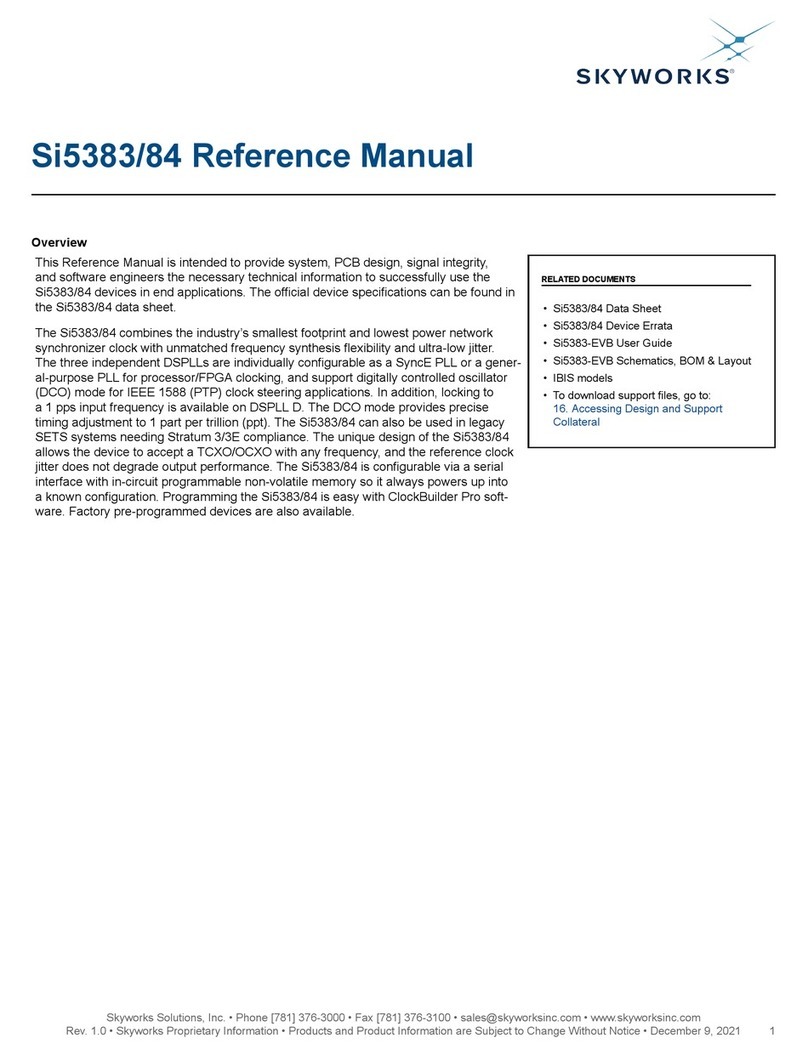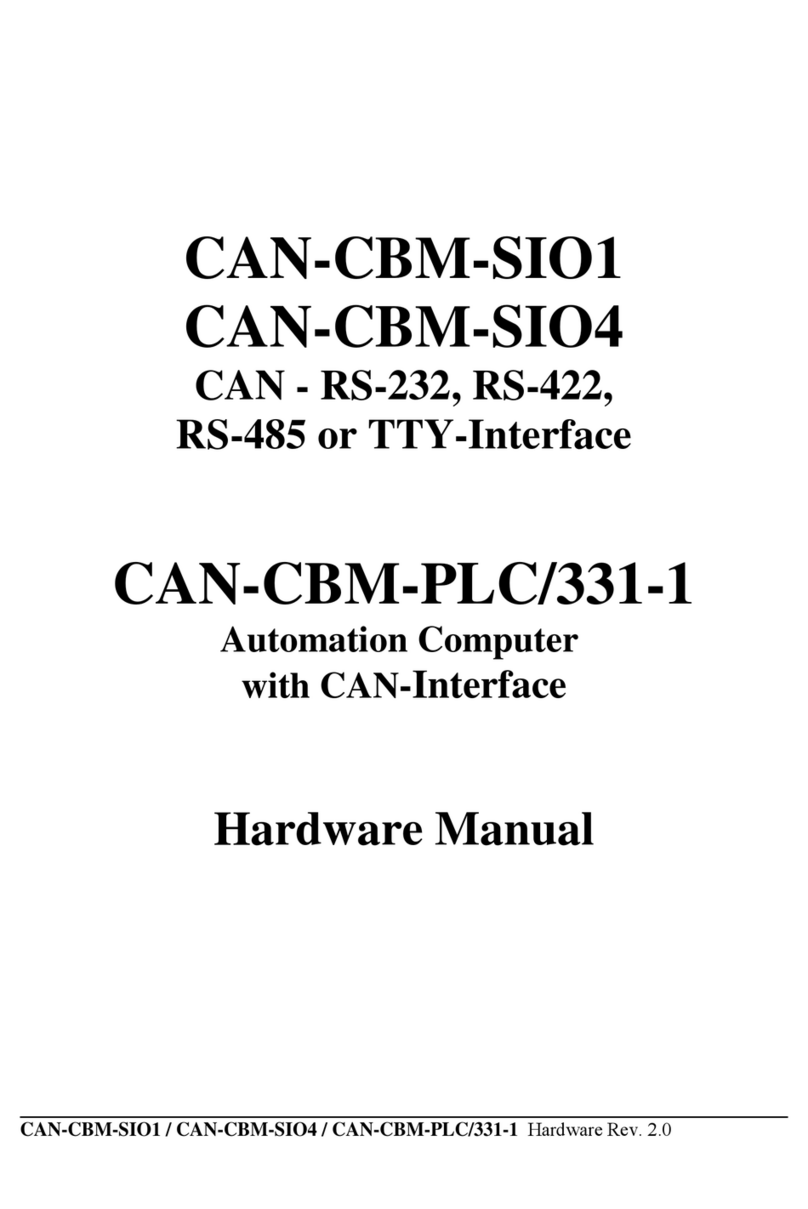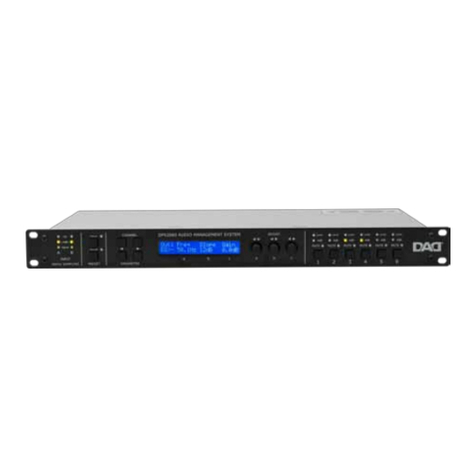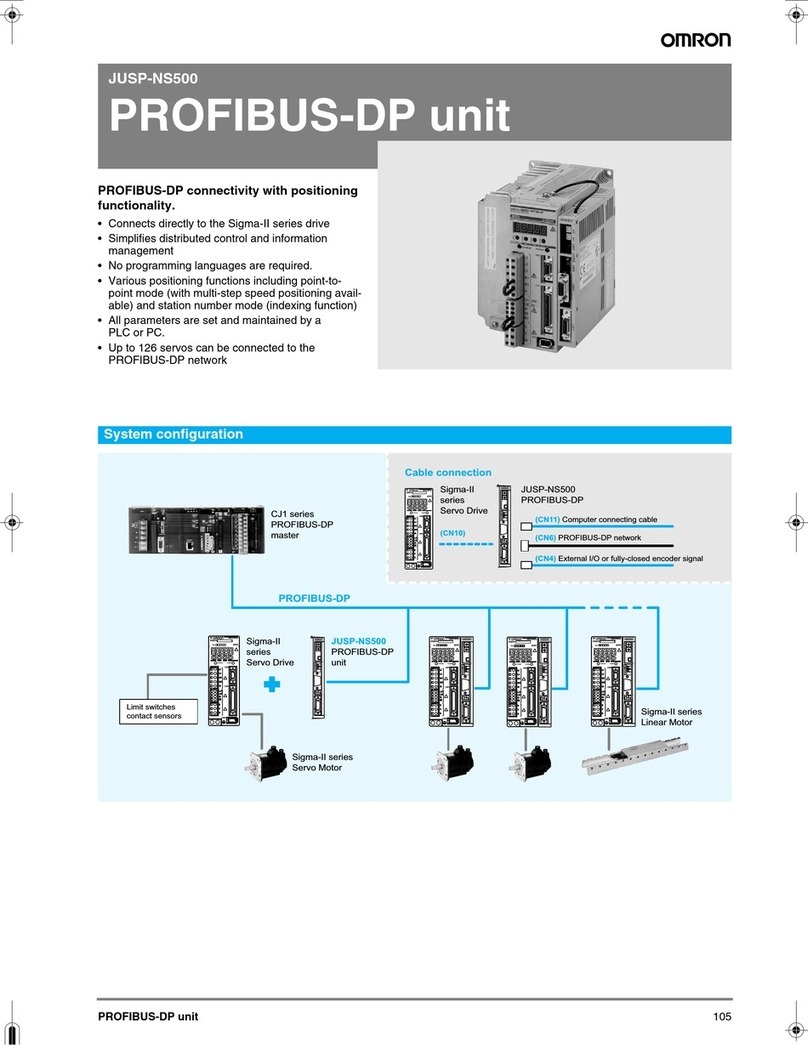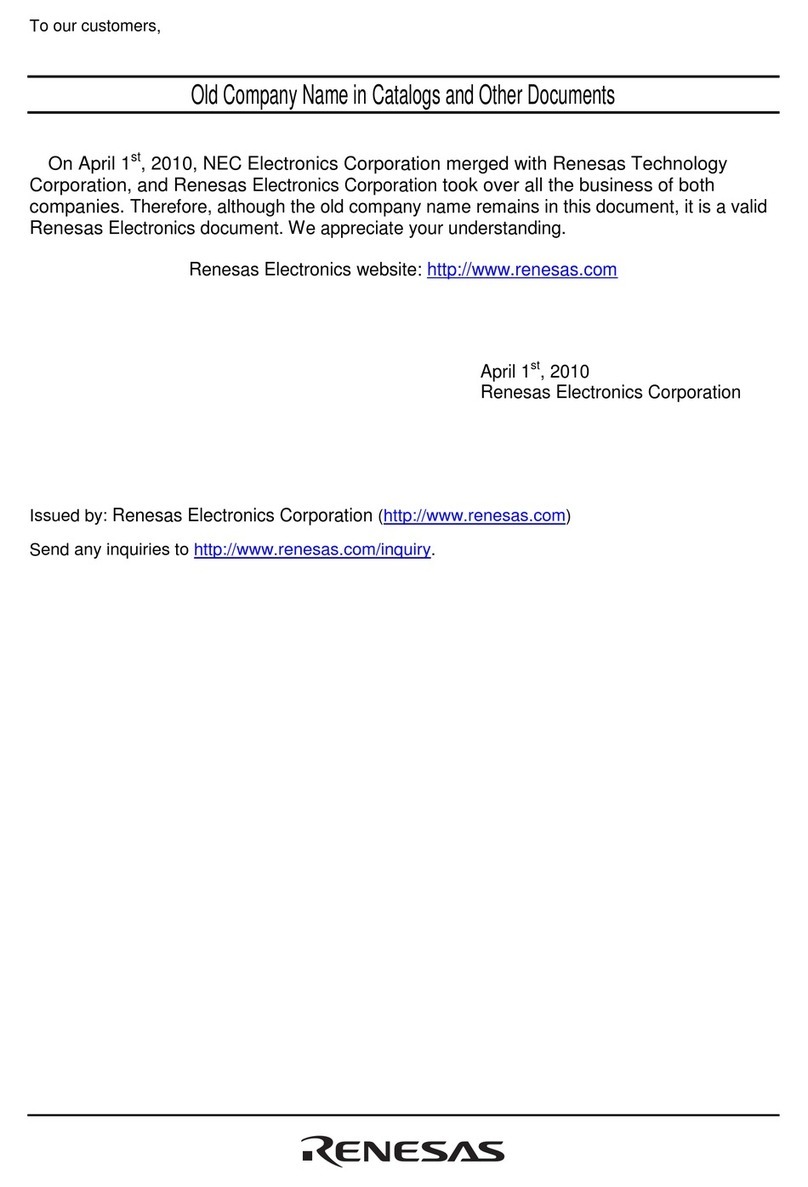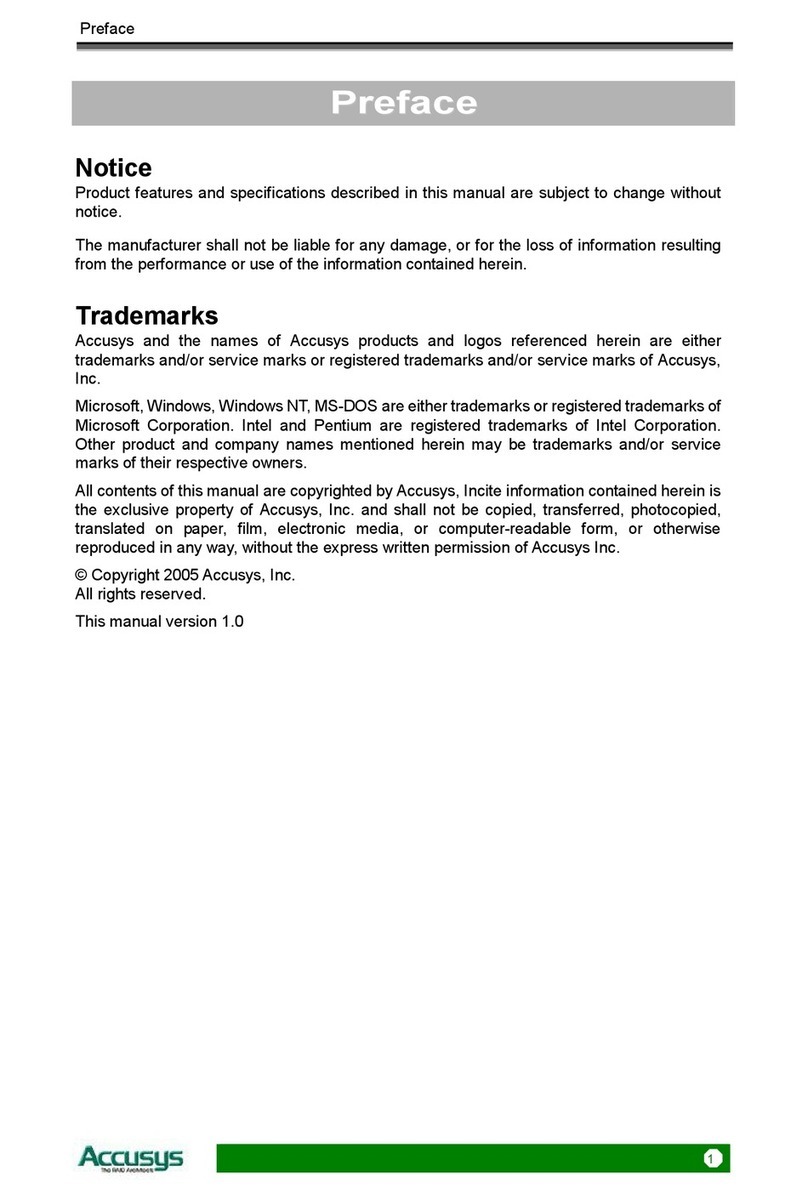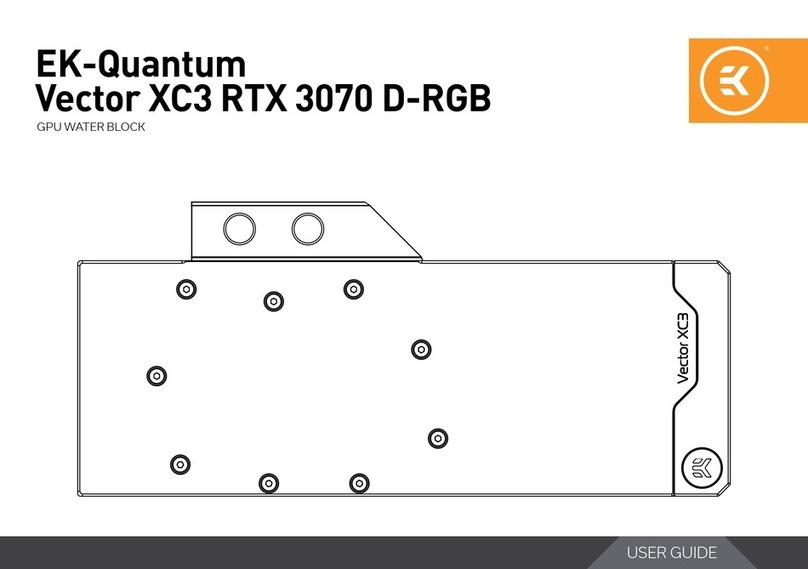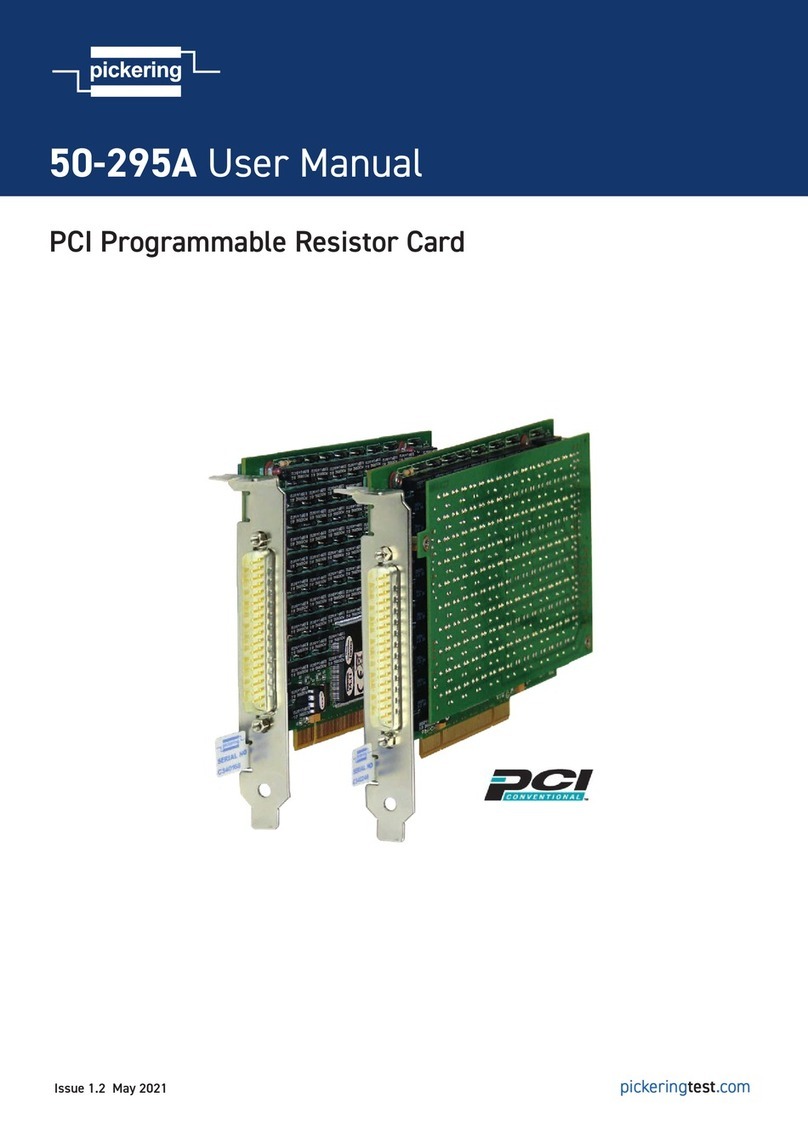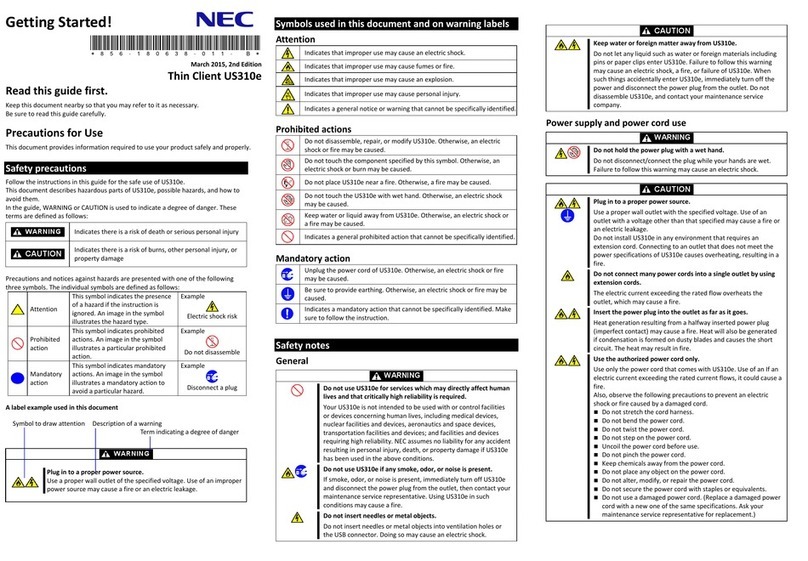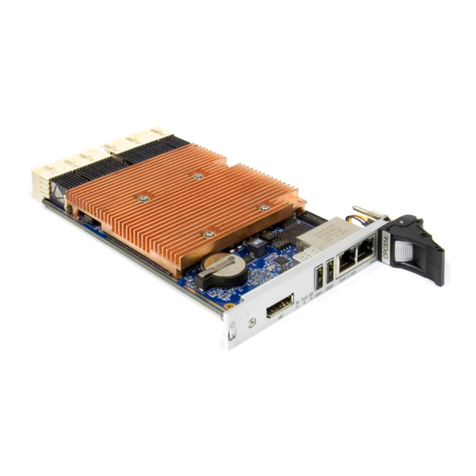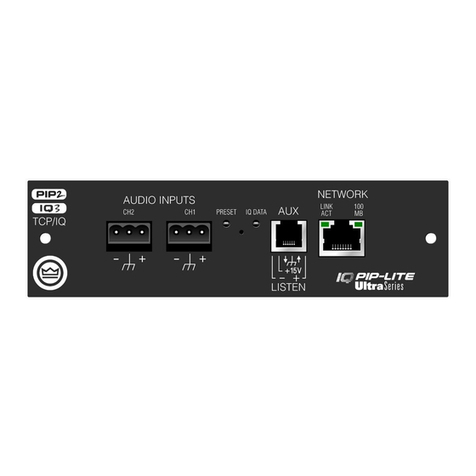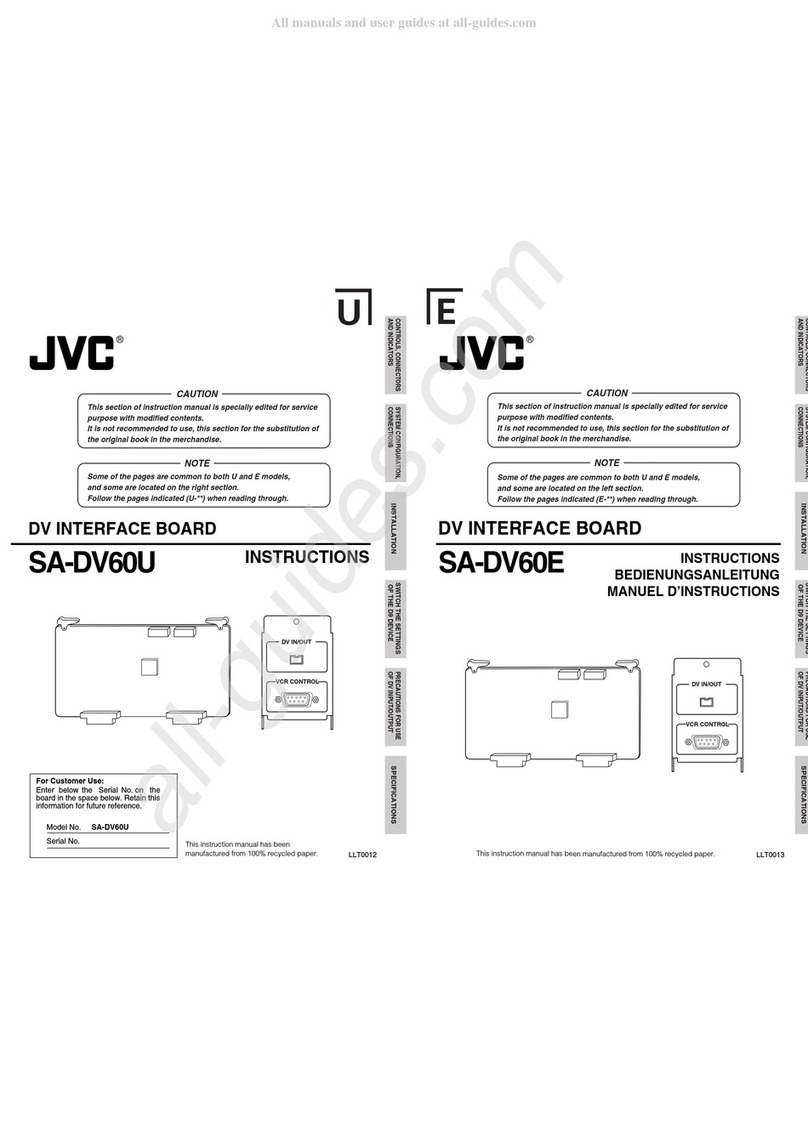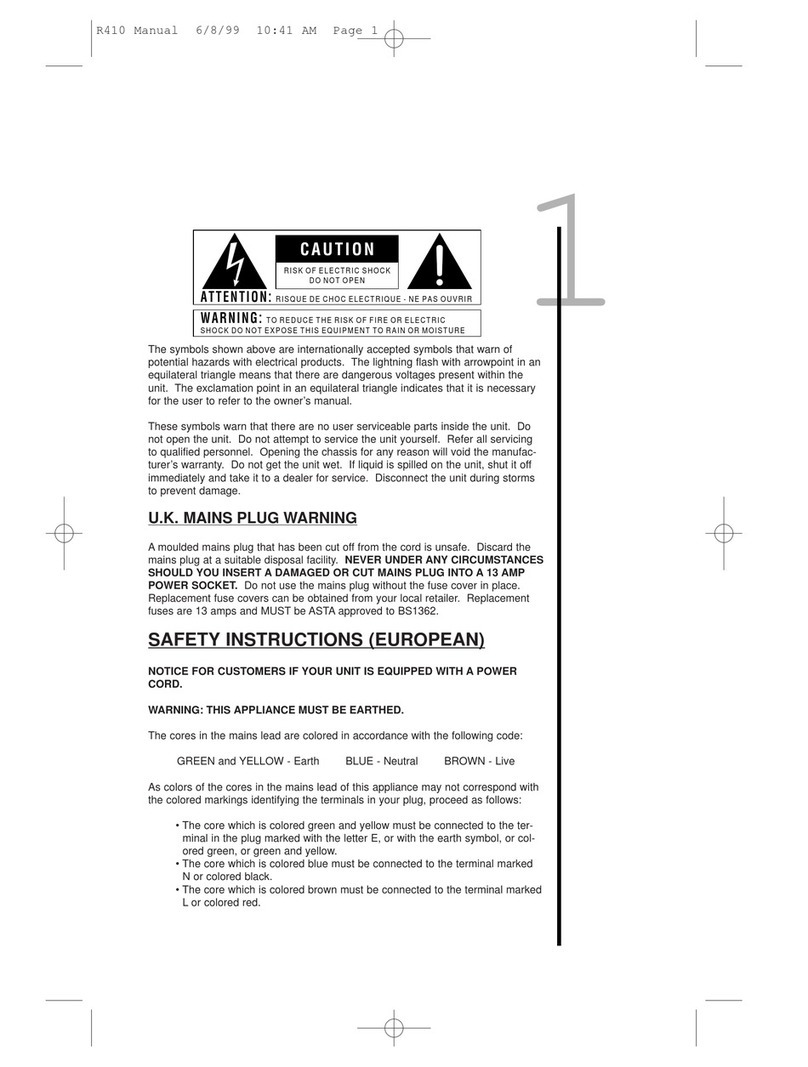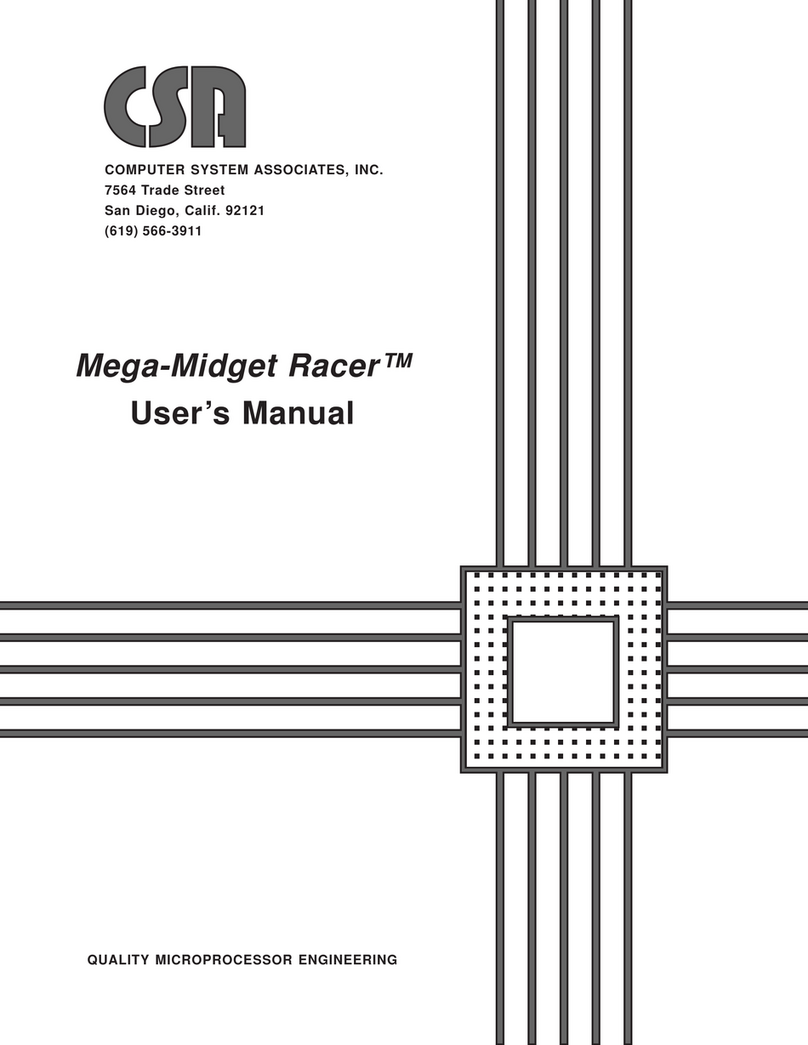Skyworks Si55 Series User manual

Si55xx, Si540x, and Si536x Recommended
XTAL, XO, VCXO, TCXO, and OCXO
Reference Manual
The purpose of this document is to provide a list of Crystals
(XTALs), Crystal Oscillators (XOs), Voltage Controlled Crystal Os-
cillators (VCXOs), Temperature Compensated Crystal Oscillators
(TCXOs), and Oven Controlled Crystal Oscillators (OCXOs), that
are recommended for use with Skyworks high-performance net-
work synchronizers, jitter attenuators and clock generators that
utilize fifth-generation DSPLL™ and MultiSynth™ technologies.
In this document, the Si5508/10/12/18 RF jitter attenuators and network synchronizers
will be referred to as the Si55xx product family, the Si5401/02/03 network synchronizers
will be referred to as the Si540x product family, and the Si5360/61/62/63 clock gener-
ators and jitter attenuators will be referred to as the Si536x product family. The recom-
mended references and reference frequencies for each product family are selected to
give best performance in their intended applications.
Customers should qualify any reference device using their own internal standards and
monitor specification compliance and quality of these devices over time. In circuit evalu-
ation, it is recommended to verify that the reference meets all application requirements.
See relevant device data sheets and reference manuals for external reference termina-
tion and layout recommendations. This document is purely intended to guide the selec-
tion of the reference oscillators that are paired with the Si55xx/Si540x/Si536x chipsets.
RELATED DOCUMENTS
• Si55xx Reference Manual
• Si540x Reference Manual
• Si536x Reference Manuals
• AN1293: Si55xx Schematic Design and
Layout Guidelines
• AN1347: Si540x Schematic Design and
Layout Guidelines
• AN1357: Si536x Schematic Design and
Layout Guidelines
RELATED SKYWORKS PARTS
• Si5512/18 RF Jitter Attenuator +
NetSyncTM wireline network synchronizer
clocks
• Si5510/08 RF Jitter Attenuators
•Si5401/02/03 NetSyncTM Wireline Network
Synchronizer Clocks
• Si5361/62/63 Jitter Attenuators
• Si5360 Clock Generator
Skyworks Solutions, Inc. • Phone [781] 376-3000 • Fax [781] 376-3100 • [email protected] • www.skyworksinc.com
1206422A • Skyworks Proprietary Information • Products and Product Information are Subject to Change Without Notice • November 9, 2022 1

Table of Contents
1. Phase Noise References (XTALs, XOs, VCXOs) ..................3
1.1 Recommended Crystals (XTALs) ........................4
1.2 Recommended Crystal Oscillators (XOs) .....................6
1.3 Recommended Voltage-Controlled Oscillators (VCXOs) ................8
2. Stability and Holdover References (TCXOs/OCXOs) ................ 10
2.1 TCXOs ................................11
2.2 OCXOs ................................12
3. Appendix A - Selecting an XTAL for Your Application ............... 14
4. Appendix B - Selecting an XTAL Oscillator for Your Application ........... 17
5. Revision History ............................. 21
Skyworks Solutions, Inc. • Phone [781] 376-3000 • Fax [781] 376-3100 • [email protected] • www.skyworksinc.com
2206422A • Skyworks Proprietary Information • Products and Product Information are Subject to Change Without Notice • November 9, 2022 2

1. Phase Noise References (XTALs, XOs, VCXOs)
Si55xx/Si540x/Si536x devices use an external quartz-based oscillator in conjunction with a high performance on-chip voltage controlled
oscillator (VCO) to generate ultra-low jitter and phase noise output clocks. This oscillator is referred to as the phase noise
reference and is required for all applications using the Si55xx/Si540x/Si536x devices. It is critical to select the proper phase noise
reference for the given device and application to optimize board design for both performance and cost. It is highly recommended to
use one of the qualified phase noise references from this document as they will result in phase noise performance in line with the data
sheet.
The Si540x wireline network synchronizers and the Si536x jitter attenuators/clock generators support either an XO or a XTAL
as the phase noise reference. The output clock jitter will be roughly equivalent between any device from the recommended list of XOs
or XTALs.
The Si55xx wireless jitter attenuators/network synchronizers support a crystal oscillator (XO), crystal (XTAL), or voltage-controlled
crystal oscillator (VCXO) as the phase noise reference. An XO is recommended for most Si55xx wireless applications. This is due
to the fact that an XO will provide the lowest close-in phase noise (10 Hz – 1 kHz). For wireless applications that are not as sensitive
to close-in phase noise either an XO or a XTAL can be used as the phase noise reference. The phase noise above a few kHz and
integrated 12 kHz-20 MHz jitter will be roughly equivalent when using any of the approved XOs/XTALs.
The Si55xx products are the only devices that support a VCXO phase noise reference. The VCXO phase noise reference is
recommended for the Si55xx devices when used in the highest performance 5G wireless applications such as mmWave
and massive MIMO. It is extremely important to select an ultra-low phase noise VCXO with a low tuning gain (Kv) like the ones
recommended in this document. A mid-tier VCXO will likely result in higher phase noise outputs clocks and a more expensive BOM cost
than using one of the recommended XOs. See the data sheet for phase noise comparisons between XO and VCXO modes.
The table below provides a summary of the supported phase noise references for each product family.
Table 1.1. Recommended Phase Noise References
Si5xxx Device Supported PN References Applications
Si5508/10/18 XO, XTAL, VCXO Wireless RU, Small Cell, Integrated Small Cell, DAS
Si5512 XO, XTAL Wireless RU, Small Cell, Integrated Small Cell, DAS, designs that
split digital and RF functions on separate board
Si5401/02/03 XO, XTAL Core/metro/access switch and routers, Wireless CU, DU and fron-
thaul switch, smart NIC
Si5361/62/63 XO, XTAL 56G/112G SerDes clocking, OTN muxponders/transponders,
switches and routers, medical imaging, test and measurement
Si5360 XO, XTAL FPGAs/processors/memory, switches and routers, OTN fram-
ers/mappers/processors, test equipment and instrumentation, broad-
cast video
Si55xx, Si540x, and Si536x Recommended XTAL, XO, VCXO, TCXO, and OCXO Reference Manual • Phase Noise References (XTALs, XOs, VCXOs)
Skyworks Solutions, Inc. • Phone [781] 376-3000 • Fax [781] 376-3100 • [email protected] • www.skyworksinc.com
3206422A • Skyworks Proprietary Information • Products and Product Information are Subject to Change Without Notice • November 9, 2022 3

1.1 Recommended Crystals (XTALs)
A crystal (XTAL) refers to a quartz crystal, which has the piezoelectric property that it vibrates at a fixed frequency when an electric field
is applied. The XTAL is driven by an on-chip circuit to form a crystal oscillator, which uses the mechanical resonance of the vibrating
crystal to yield a fixed frequency electrical oscillation. This provides an ultra-low jitter oscillator input to the Si55xx/Si540x/Si536x device
that is used as the phase noise reference for the phase locked loop (PLL). The allowed frequency range for the XTAL is 48-54 MHz.
The following figure shows the crystal reference connected to the XA/XB pins of the device.
Si55xx/
Si540x/
Si536x
XTAL
XA XB
Figure 1.1. Si55xx/Si540x/Si536x Clock with XTAL Phase Noise Reference on XA/XB
Table 1.2 Recommended Crystals, XTALs on page 5 lists the XTALs that are recommended for use as the phase noise reference
on the XA/XB pins of Si55xx/Si540x/Si536x devices. While it is encouraged to use one of the recommended XTALs which have been
tested and qualified, other XTALs may be used. See 3. Appendix A - Selecting an XTAL for Your Application, in particular the ESR vs
C0 requirement, will be guaranteed to oscillate.
XTALs that meet the specifications outlined in this document may be submitted to Skworks for future qualification consideration for
use with the clocks listed above. Some of the part numbers in this table are custom generated for Skworks. Part Family information is
included in the table to enable searching through vendor websites. Users can also contact the vendor directly and ask for the specific
part number listed. The oscillation frequency vs temperature curve of the XTALS specified will have a shape of an S-curve. However,
there can be small deviations from the S-curve primarily due to imperfect internal connections to the actual physical XTAL blank. These
deviations are called Frequency Perturbations. In some applications, it is important that the Frequency Perturbation be limited to a
maximum value. Some XTALS specify a maximum for Frequency Perturbations and others do not. It is recommended that an XTAL
have a max Frequency Perturbations spec of no more than 2 ppm/2 °C. This means that over a 2 °C temperature range that the XTAL
frequency will not change by more than 2 ppm from the normal S-curve shape.
The figures in this document are meant to be high level. For example, design details like the XTAL ground shield (XV) are not shown
in the figure above. See the appropriate product reference manual and Si55xx/Si540x/Si536x Schematic Design and Layout Guidelines
Application Note for more detailed XTAL connections and layout recommendations.
Si55xx, Si540x, and Si536x Recommended XTAL, XO, VCXO, TCXO, and OCXO Reference Manual • Phase Noise References (XTALs, XOs, VCXOs)
Skyworks Solutions, Inc. • Phone [781] 376-3000 • Fax [781] 376-3100 • [email protected] • www.skyworksinc.com
4206422A • Skyworks Proprietary Information • Products and Product Information are Subject to Change Without Notice • November 9, 2022 4

Table 1.2. Recommended Crystals, XTALs
Supplier Part Number
Freq
(MH
z)
Initial
Toler-
ance
(±ppm)
Operating
Temp (C)
Freq
Error
over
Operat-
ing
Temp
Range
(±ppm)
C0
Max
(pF)
ESR
Max
(ohms)
CL
(pF)
Pullability
max1 (ppm/pf) Qmin
Activity
Dip
Guar-
anteed
2ppm/C
max?
Drive Lev-
el max
(µW)
Pack-
age
Size
(mm)
TXC 7M48072009 48 10 –40 to 105 20 2.0 22 8.0 35 30k Yes 200 3.2 x
2.5
TXC 7M54072006 54 10 –40 to 105 20 2.0 22 8.0 35 30k Yes 200 3.2 x
2.5
Kyocera CX3225SB48000
D0FRRC1
48 10 –40 to 105 40 2.0 25 8.0 35 — Yes 200 3.2 x
2.5
Kyocera CX3225SB54000
D0FRRC1
54 10 –40 to 105 40 2.0 25 8.0 35 — Yes 200 3.2 x
2.5
Taitien S0242-X-004-3 48 15 –40 to 105 35 2.0 25 8.0 35 30k Yes 200 3.2 x
2.5
Taitien S0242-X-005-3 54 10 –40 to 105 45 2.0 30 8.0 35 30k Yes 200 3.2 x
2.5
Note:
1. Pullability is the change is oscillation frequency when CL is not exactly 8 pf.
Xtal Vendor contact information
TXC
www.txccorp.com
USA office phone number 714-990-5510
Kyocera
https://global.kyocera.com/prdct/electro/
Si55xx, Si540x, and Si536x Recommended XTAL, XO, VCXO, TCXO, and OCXO Reference Manual • Phase Noise References (XTALs, XOs, VCXOs)
Skyworks Solutions, Inc. • Phone [781] 376-3000 • Fax [781] 376-3100 • [email protected] • www.skyworksinc.com
5206422A • Skyworks Proprietary Information • Products and Product Information are Subject to Change Without Notice • November 9, 2022 5

1.2 Recommended Crystal Oscillators (XOs)
Some applications, in particular RF/wireless clocking (Si55xx), are sensitive to close-in phase noise. For these applications, a crystal
oscillator (XO) is recommended as the phase noise reference. Some customers also tend to use an XO instead of a XTAL for
its superior reliability and performance over temperature. The recommended frequency range for the XO is 48-54 MHz for best
performance although a wider range of XO frequencies is supported as specified in the device data sheet.
Compared to a discrete XTAL, an XO will have less total frequency error when taking into account all factors. Using an XO instead of a
XTAL will:
• Produce output clocks with lower phase noise for offsets less than 1 kHz.
• Deliver greater immunity to vibration and airflow effects. This may result in lower phase noise below ~50 Hz.
• Deliver better temperature stability with the frequency changes of an XO being less than that of a XTAL. Because of this, a jitter
attenuator device can have a lower bandwidth and still filter out these oscillation frequency changes.
• Deliver better accuracy in free-run since the accuracy of an XO is far better than that of a XTAL.
The jitter of the XO applied to the Si55xx/Si540x/Si536x device has a large effect on the output jitter/phase noise for offset frequencies
up to ~1.5 MHz. The following figure shows the XO phase noise reference connected to the clock. Note the distinction that XOs should
be connected to the REF_IN pins for Si55xx devices and the XO_IN for Si540x/Si536x devices whereas XTALs are always connected
to the XA/XB pins. The REF_IN/XO_IN can support a DC coupled single-ended CMOS XO input or an AC coupled differential XO input
to REF_IN/XO_IN and REF_INB/XO_INB. In general, single ended CMOS XO inputs are far more common for the recommended XO
frequency range as they can achieve lower phase noise floor with respect to differential XOs.
Si55xx
REF_IN
XO
Si540x/
Si536x
XO_IN
XO
Figure 1.2. Si55xx/Si540x/Si536x Clocks with XO Phase Noise Reference on REF_IN Input
The figures in this document are meant to be high level. See the appropriate product reference manual and Si55xx/Si540x/Si536x
Schematic Design and Layout Guidelines Application Note for XO input connections and specification limits, rise/fall times, input
circuits, input level specifications, and performance tradeoffs. Also, see the design/layout guideline application notes for how to power
XOs.
Si55xx, Si540x, and Si536x Recommended XTAL, XO, VCXO, TCXO, and OCXO Reference Manual • Phase Noise References (XTALs, XOs, VCXOs)
Skyworks Solutions, Inc. • Phone [781] 376-3000 • Fax [781] 376-3100 • [email protected] • www.skyworksinc.com
6206422A • Skyworks Proprietary Information • Products and Product Information are Subject to Change Without Notice • November 9, 2022 6

The table below lists the XOs that are recommended for use as the phase noise reference of the Si55xx/Si530x/Si536x devices.
To deliver optimum performance, either these recommended XOs or one of equivalent phase noise and jitter performance must be
selected.
Note: Some of the part numbers in this table are custom generated for Skyworks. Part Family information is included in the
table to enable searching through vendor websites. Users can also contact the vendor directly and ask for the specific part
number listed.
Table 1.3. Recommended XO Phase Noise References
Supplier Part Number Part
Family
Freq
(MHz) Temp °C
Total
Frequency
Stability
(±ppm)1
Supply
Voltage2
Package
Size (mm) Notes
NDK NZ2520SDA-48M-
CUS5242A NZ2520SDA 48 –40 to 105 50 3.3 V 2.5 x 2.0 3
TXC 7X48070007 7X 48 –40 to 105 50 3.3 V 3.2 x 2.5 3
TXC 8W48070009 8W 48 –40 to 85 25 3.3 V, 1.8 V 2.5 x 2.0 3
NDK NZ2520SDA-54M-
CUS5094C NZ2520SDA 54 –40 to 105 50 3.3 V 2.5 x 2.0 3, 4
TXC 7X54070001 7X 54 –40 to 105 50 3.3 V 3.2 x 2.5 3, 4
TXC 7X54070002 7X 54 –40 to 105 50 1.8 V 3.2 x 2.5 3, 4
TXC 8W54070002 8W 54 –40 to 105 50 3.3 V 2.5 x 2.0 3, 4
TXC 8W54070004 8W 54 –40 to 85 25 3.3 V, 1.8 V 2.5 x 2.0 3, 4
Note:
1. Includes initial accuracy, temperature, aging, and soldering effects.
2. 1.8 V supply voltage should only be used for low-power mode applications in which VDDRED = VDDA = 1.8 V.
3. Recommended for use on Si540x (Si5401/02/03) and Si536x (Si5360/61/62/63) devices.
4. Recommended for use on Si55xx (Si5508/10/12/18) devices.
Si55xx, Si540x, and Si536x Recommended XTAL, XO, VCXO, TCXO, and OCXO Reference Manual • Phase Noise References (XTALs, XOs, VCXOs)
Skyworks Solutions, Inc. • Phone [781] 376-3000 • Fax [781] 376-3100 • [email protected] • www.skyworksinc.com
7206422A • Skyworks Proprietary Information • Products and Product Information are Subject to Change Without Notice • November 9, 2022 7

1.3 Recommended Voltage-Controlled Oscillators (VCXOs)
The Si5508/10/18 devices support a voltage-controlled crystal oscillator (VCXO) phase noise reference. Note the Si5512 is the only
device in the Si55xx product family which does not support a VCXO phase noise reference. Even though for most wireless 5G
applications the Si55xx + XO phase noise reference is sufficient in some high end RF applications like mmWave and massive MIMO,
a VCXO may be advantageous due to the slightly lower mid-band phase noise and RMS jitter. The recommended VCXOs in the table
below have ultra-low phase noise floor along with a low tuning gain (Kv) which is critical for achieving low close-in phase noise with a
VCXO often required for wireless applications. It is extremely critical to use a VCXO from Table 1.3 below or one of equal performance.
If a customer selects a VCXO that is not on the recommended listed in this document, the Si55xx output phase noise will
likely be WORSE than using a recommended XO. A mid-tier VCXO will likely result in higher phase noise outputs clocks and a more
expensive BOM cost than using one of the recommended XOs. See the Si55xx data sheets for phase noise comparisons between XO
and VCXO modes.
One key distinction between an XO/XTAL and a VCXO phase noise reference is that the VCXO frequency is steered by the voltage
control (VC) output from the on-chip high resolution DAC compared to a free-running XTAL/XO phase noise reference in which the
PLL output frequency is steered internally by an on-chip high resolution digital divider. Because the VCXO frequency matches the
desired output frequency, VCXO buffer mode outputs are supported. The buffered copy of the VCXO can provide the lowest midband
phase noise output clock (1k-1M) to meet the most stringent phase noise masks for output clocks providing synchronization to radio
equipment such as an RF LO, phased-array antenna or high performance ADC/DAC.
The Si5508/10/18 devices support both DC coupled single ended CMOS and AC coupled differential VCXOs. It is recommended to use
a VCXO with a frequency greater than or equal to 122.88 MHz. The desired high performance RF clock output frequency should be
integer related to the VCXO frequency. The figures in this document are meant to be high level. See the appropriate Product reference
manual for input connections and terminations.
Si5508/
10/18
REF_IN
VCXO
VC
Figure 1.3. Si5508/10/18 Clock with VCXO Phase Noise Reference on REF_IN Input
Si55xx, Si540x, and Si536x Recommended XTAL, XO, VCXO, TCXO, and OCXO Reference Manual • Phase Noise References (XTALs, XOs, VCXOs)
Skyworks Solutions, Inc. • Phone [781] 376-3000 • Fax [781] 376-3100 • [email protected] • www.skyworksinc.com
8206422A • Skyworks Proprietary Information • Products and Product Information are Subject to Change Without Notice • November 9, 2022 8

Table 1.4. Recommended VCXO Phase Noise References for Si5508/10/18 Devices1
Supplier Part Number Part Family Freq (MHz) Temp °C Package Size
(mm)
Absolute Pull
Range, APR
(±ppm)
Rakon V41042RVX1490U 122.88 –40 to 85 9 x 14 5
Rakon V4185 RVX1490U 122.88 –40 to 95 9 x 14 10
Rakon V4173 RVX1490U 153.6 –40 to 85 9 x 14 5
Epson H20-065-0A VG3225EFN 204.8 –40 to 85 3.2 x 2.5 20
Epson CJGHSA VG332EFN 491.52 –40 to 85 3.2 x 2.5 10
TXC CJB0470001 204.8 –40 to 85 3.2 x 5 50
TXC DRA5370001 153.6 –40 to 85 3.2 x 5 5
Note:
1. Includes initial calibration, temperature range, aging, soldering effects, and supply-and-load variation.
2. V4104 is not recommended for new designs. For new designs, use V4185.
Si55xx, Si540x, and Si536x Recommended XTAL, XO, VCXO, TCXO, and OCXO Reference Manual • Phase Noise References (XTALs, XOs, VCXOs)
Skyworks Solutions, Inc. • Phone [781] 376-3000 • Fax [781] 376-3100 • [email protected] • www.skyworksinc.com
9206422A • Skyworks Proprietary Information • Products and Product Information are Subject to Change Without Notice • November 9, 2022 9

2. Stability and Holdover References (TCXOs/OCXOs)
Network synchronization applications, such as IEEE-1588 and Synchronous Ethernet ITU-T G.8262/G.8262.1 (SyncE), require low
wander in addition to the traditional low jitter/phase noise requirement. A compensated crystal oscillator such as a TCXO or OCXO is
required to provide stability to support the low bandwidths specified for SyncE PLLs (0.1-10 Hz BW) and/or IEEE-1588 servo loops
(1-100 mHz BW). For SyncE and/or full timing support (FTS) applications as described in ITU-T G.8275.1 a TCXO is recommended.
For applications that require PLL or servo loop bandwidths less than 100 mHz or for applications that require SyncE and/or time
holdover an OCXO is recommended. This includes 1PPS (Pulse Per Second)/PP2S (Pulse Per 2 Seconds) PLLs, which are commonly
required to lock to GNSS receivers for partial/assisted partial timing support (PTS/APTS) applications as described in ITU-T G.8275.2.
See Sections 2.1 and 2.2 for more details on selecting the right quality oscillator for a given application.
The Si540x and Si5512/18 network synchronizer devices support these applications using two reference oscillators in dual reference
mode. In this mode, the phase noise reference is applied to the device in the same manner as described in Section 1 (for example to
the XA/XB pins when using a XTAL) along with a second TCXO/OCXO reference for stability and optional holdover. The TCXO/OCXO
is applied to the input pins (INx) in the case of the Si5512/18 and the dedicated REF pin in the case of the Si540x. The Si540x require
dual reference mode while the Si5512/18 can support either dual or single reference modes configurable in ClockBuilder Pro. The
Si536x and Si5508/10 do not support dual reference mode.
Note: See the applicable Skyworks product Reference Manual for rise/fall time, input circuits, input level specifications and perform-
ance tradeoffs.
Si540x
XTAL
XA XB
OCXO/
TCXO
REF
Figure 2.1. Si540x Network Synchronizer with OCXO/TCXO and XTAL Reference
Si5512/18
OCXO/
TCXO
INx
REF_IN
XO
Figure 2.2. Si5512/18 RF JA + Network Synchronizer with OCXO/TCXO and XO Reference
Si55xx, Si540x, and Si536x Recommended XTAL, XO, VCXO, TCXO, and OCXO Reference Manual • Stability and Holdover References (TCXOs/
OCXOs)
Skyworks Solutions, Inc. • Phone [781] 376-3000 • Fax [781] 376-3100 • [email protected] • www.skyworksinc.com
10 206422A • Skyworks Proprietary Information • Products and Product Information are Subject to Change Without Notice • November 9, 2022 10

2.1 TCXOs
A TCXO is recommended for network synchronization applications supporting SyncE and when used in a full timing support network
(FTS) as described in ITU-T G.8275.1. An FTS network is engineered such that every node in the network supports IEEE-1588. This
results in a nearly ideal case for low Ethernet packet delay variation (PDV) throughout the network and allows for a wider servo loop
bandwidth of 50–100 MHz. The timing characteristics and transfer functions between SyncE and IEEE-1588 input/outputs are outlined
in ITU-T G.8273.2 which defines a Telecom Boundary Clock (T-BC) or Telecom Slave Clock (T-TSC) for an FTS network. Relying on
SyncE stabilization allows the designer to select a lower cost TCXO. In the absence of SyncE or if time holdover is required,
an OCXO is recommended as described in Section 2.2.
The table below lists the TCXOs that have been tested and approved for use with the Si5512/18 and Si540x network synchronizer
devices for ITU-T G.8262 EEC Options 1 and 2 (SyncE) and ITU-T eEEC G.8262.1 (Enhanced SyncE) and T-BC/T-TSC G.8273.2
applications. Contact Skyworks support for SyncE, Enhanced SyncE, and G.8273.2 compliance reports. All recommended TCXOs are
required to be Stratum 3 level of performance.
Note: Some of the part numbers in this table are custom-generated for Skyworks. Part family information is included in the
table to enable searching through vendor web sites. Users can also contact vendors directly and ask for specific listed part
numbers.
Table 2.1. Recommended TCXO Approved For SyncE and T-BC/T-TSC Applications
Supplier Part No Part Family Freq (MHz)1
Stability over
Temp
(±ppb)
Temp °C Stratum Package
Size (mm) Notes
TXC 7N10071003 7N 10 250 –40 to 105 3 7 x 5 Notes 1, 2, 3
TXC 7N10070005 7N 10 140 –40 to 85 3 7 x 5 Notes 1, 2, 3
Rakon E8268LF RNT7050A 10 50 –40 to 85 3 7 x 5 Notes 1, 2, 3
Rakon E6413LF RPT7050J 12.8 140 –40 to 85 3 7 x 5 Note 2
TXC 7N19471003 7N 19.44 250 –40 to 105 3 7 x 5 Notes 1, 2
TXC 7N19471005 7N 19.44 140 –40 to 85 3 7 x 5 Notes 1, 2
TXC 7N20070004 7N 20 250 –40 to 105 3 7 x 5 Notes 1, 2, 3
TXC 7N20071005 7N 20 140 –40 to 85 3 7 x 5 Notes 1, 2, 3
TXC 7N38871002 7N 38.88 250 –40 to 105 3 7 x 5 Notes 1, 2
TXC 7N38871003 7N 38.88 140 –40 to 85 3 7 x 5 Notes 1, 2
TXC 7N48071001 7N 48 250 –40 to 105 3 7 x 5 Notes 1, 2
TXC 7N48071005 7N 48 140 –40 to 85 3 7 x 5 Notes 1, 2
Note:
1. TCXO frequencies of 10*N MHz should be avoided for applications in which a 10 MHz input will be applied to the Si5xxx network
synchronizer as they may cause coupling. Avoid this TCXO frequency for applications which have a 10 MHz input from a GNSS
receiver.
2. Recommended for use on Si5512/18 devices.
3. Recommended TCXO for use on Si5401/02/03 devices.
Si55xx, Si540x, and Si536x Recommended XTAL, XO, VCXO, TCXO, and OCXO Reference Manual • Stability and Holdover References (TCXOs/
OCXOs)
Skyworks Solutions, Inc. • Phone [781] 376-3000 • Fax [781] 376-3100 • [email protected] • www.skyworksinc.com
11 206422A • Skyworks Proprietary Information • Products and Product Information are Subject to Change Without Notice • November 9, 2022 11

2.2 OCXOs
An OCXO is recommended for network synchronization applications that do not support SyncE, require time holdover and/or when
used in partial/assisted partial timing support (PTS/APTS) network as described in ITU-T G.8275.2. A PTS network is defined as a
network that does not support IEEE-1588 at every node. APTS is a technique of deploying Global Navigation Satellite Systems (GNSS)
receivers throughout a PTS network to serve as the primary source of timing for all downstream nodes. In APTS when GNSS becomes
unavailable, the IEEE-1588 protocol is used to maintain synchronization. The timing characteristics for a PTS network are outlined in
ITU-T G.8273.4 which defines a T-BC-P and T-TSC-P for partial timing support and a T-BC-A and T-TSC-A for assisted partial timing
support.
Since a PTS network has nodes that do not support IEEE-1588, the Ethernet packets transmitted throughout the network experience
significantly more packet delay variation (PDV). To support the PTS profile, typically a lower servo loop bandwidth (1 mHz or less) must
be used to filter out the PDV. In addition to more PDV, many PTS networks do not support SyncE so the output clock stability and
wander tracks the oscillator all the way down to the low servo loop bandwidth. A TCXO will likely not provide low enough wander to
support PTS and an OCXO is strongly recommended.
The table below lists the OCXOs recommended for use with the Si5512/18 and Si540x network synchronizer devices for T-BC-A/T-
TSC-A/T-BC-P/T-TSC-P G.8273.4, ITU-T G.8262 EEC Options 1 & 2, ITU-T eEEC G.8262.1, and T-BC/T-TSC G.8273.2 applications.
The table below additionally provides approximate holdover times supported for each OCXO. It is recommended to verify holdover
times with the OCXO vendor as they will vary depending on parameters such as temperature variation for the given application. A
Stratum 3E level OCXO or better should be used for all applications requiring time holdover.
Note: Some of the part numbers in this table are custom generated for Skyworks. Part Family information is included in the table to
enable searching through vendor web sites. Users can also contact the vendor directly and ask for specific listed part numbers.
Table 2.2. Recommended OCXOs for SyncE, Time Holdover, and T-BC-A/T-TSC-A, T-BC-P/T-TSC-P Applications
Supplier Part No Part Family
Freq
(MHz)
1
Temp (°C)
Stabil-
ity
over
temp
(±ppb)
Stra-
tum
Level
ADEV @
Tau = 1s
(ppt)
Package
Size
(mm)
Approx
Holdover
Time
Suppor-
ted
(hours)2
Notes
Rakon STP3541LF ROX2522S3 10 –40 to 85 1 3E 5 25 x 22 4–8 Notes 1, 3, 4
TXC OG10070001 OG 10 –40 to 85 20 3 20 9.5 x 7.3 0.5–1 Notes 1, 3, 4
Rakon U8323LF RTH7050PA 10 –40 to 85 20 3 20 7.5 x 5.5 0–0.5 Notes 1, 3, 4
Rakon STP3158LF ROX2522S4 12.8 –40 to 85 10 3E 5 25 x 22 1–4 Note 4
Rakon U8567LF ROM1490E 19.44 –40 to 85 5 3E 20 14.2 x 9.2 2–4 Notes 1, 3, 5
Rakon STP3609LF ROX2522S3 19.44 –40 to 85 5 3E 5 25 x 22 4–8 Notes 3, 4
TXC OG19470001 OG 19.44 –40 to 85 20 3 20 9.5 x 7.3 0.5–1 Notes 3, 4
TXC OH19470001 OH 19.44 –40 to 85 50 3 20 7 x 5 0–0.5 Notes 3, 4
TXC OH19470002 OH 19.44 –40 to 95 50 3 20 7 x 5 0–0.5 Notes 3, 4
TXC OK19470001 OK 19.44 –40 to 85 50 3 20 5.5 x 3.7 0–0.5 Notes 3, 4
TXC OK19470002 OK 19.44 –40 to 95 50 3 20 5.5 x 3.7 0–0.5 Notes 3, 4
CTS 1498010‐
19M440 Model 149 19.44 –40 to 85 10 3E 50 14.9 x 9.7 2–4 Notes 3, 4
TXC OG20070003 OG 20 –40 to 85 20 3 20 9.5 x 7.3 0.5–1 Notes 1, 3, 4
Rakon STP3608LF ROX2522S3 38.88 –40 to 85 3 3E 5 25 x 22 4–8 Notes 3, 4
Rakon U8050LF ROM9070PA 38.88 –40 to 85 20 3 20 9.7 x 7.5 0–0.5 Notes 3, 4
Rakon U8429LF RTH7050PA 38.88 –40 to 85 20 3 20 9.7 x 7.5 0–0.5 Notes 3, 4
Rakon U8568LF ROM1490E 38.88 –40 to 85 5 3E 20 14.2 x 9.2 2–4 Notes 3, 4
Si55xx, Si540x, and Si536x Recommended XTAL, XO, VCXO, TCXO, and OCXO Reference Manual • Stability and Holdover References (TCXOs/
OCXOs)
Skyworks Solutions, Inc. • Phone [781] 376-3000 • Fax [781] 376-3100 • [email protected] • www.skyworksinc.com
12 206422A • Skyworks Proprietary Information • Products and Product Information are Subject to Change Without Notice • November 9, 2022 12

Supplier Part No Part Family
Freq
(MHz)
1
Temp (°C)
Stabil-
ity
over
temp
(±ppb)
Stra-
tum
Level
ADEV @
Tau = 1s
(ppt)
Package
Size
(mm)
Approx
Holdover
Time
Suppor-
ted
(hours)2
Notes
TXC OH38870001 OH 38.88 –40 to 85 50 3 20 7 x 5 0–0.5 Notes 3, 4
TXC OH38870003 OH 38.88 –40 to 95 50 3 20 7 x 5 0–0.5 Notes 3, 4
TXC OK38870001 OK 38.88 –40 to 85 50 3 20 5.5 x 3.7 0–0.5 Notes 3, 4
TXC OK38870002 OK 38.88 –40 to 95 50 3 20 5.5 x 3.7 0–0.5 Notes 3, 4
Rakon U7958LF ROM9070PA 48 –40 to 85 20 3 20 9.7 x 7.5 0–0.5 Notes 3, 4
TXC OG48070001 OG 48 –40 to 85 20 3E 20 9.5 x 7.3 0.5–1 Notes 3, 4
Note:
1. OCXO frequencies of 10*N MHz should be avoided for applications in which a 10 MHz input from will be applied to the Si5xxx
network synchronizer as they may cause coupling. Avoid this OCXO frequency for applications which have a 10 MHz input from a
GNSS receiver.
2. The holdover times listed are approximates provided by the supplier. Skyworks does not test holdover. Contact the supplier for
more detailed holdover questions and test reports.
3. Recommended for use on Si5512/18 devices.
4. Recommended for use on Si5401/02/03 devices.
5. Not yet tested by Skyworks but expected to be compliant based on their data sheet specifications.
Si55xx, Si540x, and Si536x Recommended XTAL, XO, VCXO, TCXO, and OCXO Reference Manual • Stability and Holdover References (TCXOs/
OCXOs)
Skyworks Solutions, Inc. • Phone [781] 376-3000 • Fax [781] 376-3100 • [email protected] • www.skyworksinc.com
13 206422A • Skyworks Proprietary Information • Products and Product Information are Subject to Change Without Notice • November 9, 2022 13

3. Appendix A - Selecting an XTAL for Your Application
The purpose of this section is to enumerate the properties of the XTAL and how it affects the final performance. As mentioned above,
XTALs operate by the piezo-electric effect. As a result, the electrical and the mechanical aspects of the XTAL have a role in determining
its aptness for the given purpose.
Data Sheet Electrical Specifications
Frequency:
An XTAL is designed to oscillate at a particular frequency as discussed in the section below. XTALs can operate at either the
fundamental frequency or at overtones of the fundamental. However, the rest of this document is about fundamental crystals which are
AT cut. AT cut refers to the way the crystal is physically cut to cause it to resonate when connected to an oscillator circuit.
Frequency Accuracy:
The construction and manufacturing process determines the accuracy and performance of the XTAL. These factors can be analyzed in
terms of the variation they cause from the ideal operating point of the XTAL.
Frequency error is a cumulative value which is a combination of multiple factors. This number needs to be within the limit specified by
the Si55xx/Si540x/Si536x device to guarantee proper PLL operation and specified performance. Accuracy is represented in parts per
million (ppm) or parts per billion (ppm).
ppm error =Actual f requency −ideal f requency /ideal f requency × 106
ppb error =Actual f requency −ideal f requency / ideal f requency × 109
Because the XTAL accuracy directly affects the output accuracy during free run, it is important that the XTAL frequency error be tight on
the temperature drift and total ppm error. The factors contributing to frequency accuracy are.
1. Initial offset or Frequency tolerance: Impurities in the XTAL growth, imprecision in the cutting process, and uneven thickness of
the processed XTAL lead to slightly different nominal oscillation frequencies across a batch of XTALs. It is usually specified at a
typical room temperature of 25°C.
2. Frequency Stability over Temperature: The XTAL oscillation frequency varies with temperature. Data sheet specifications give
the minimum and maximum variation above and below the oscillation frequency at 25°C.
3. Aging: XTALs are electromechanical devices and are therefore subject to aging due to internal and external factors. Aging is
typically higher during the first year of operation and slows down over time. For the Si55xx/Si540x/Si536x products, Skyworks
specifies aging for 10 years at 50 °C. Most of the aging occurs in the first year.
4. Pulling sensitivity or Pull-ability: The oscillation frequency of the XTAL depends on the load capacitance and will be affected by
the tolerance of the loading capacitors. It is usually expressed in ppm/pF of capacitance variation.
5. Effects of High-Temperature Reflow: The reflow process subjects the XTAL to high temperature soldering followed by cooling.
This may cause a small shift in the frequency, specified in ppm. This specification may also list how many reflows are accounted
for in the measurement to account for re-work.
6. Activity Dips (Frequency Perturbation): Variations in the XTAL oscillation frequency from its S curve are called activity dips. One
common reason for activity dips is imperfections in the mechanical contact of the bond wire to the XTAL blank. About 2% of XTALs
will have activity dips of more than 2 ppm/C. In some cases it is important to buy XTALs that are tested to eliminate all activity dips
of more than 2 ppm/C. However, many applications do not require the extra test.
The total frequency error is a sum of individual errors.
Let’s consider an example to understand how to calculate the total error. Let’s say that a 48 MHz XTAL has a frequency tolerance
of ±13 ppm, frequency stability of ±30 ppm over temperature, long term aging at 50 C of ± 10 ppm, pulling sensitivity of 30 ppm/pF,
frequency perturbation of ±2 ppm, and a frequency drift after reflow of ±2ppm. Assume a ± 0.5 pf total variation in the capacitance
across the crystal pins.
The total error from the XTAL is a sum of all these factors, which amounts to 13 + 30 + 10 + (0.5 *30) + 2 + 2 = 72 ppm.
Operating temperature:
This is the temperature range that guarantees the operation of the XTAL per data sheet specifications. This temperature range should
be wide enough to meet the expected system operating temperature range.
XTAL Equivalent Model
A quartz XTAL can be modelled electrically as a series RLC in parallel with a capacitance indicating the connections as shown in the
figure below.
Si55xx, Si540x, and Si536x Recommended XTAL, XO, VCXO, TCXO, and OCXO Reference Manual • Appendix A - Selecting an XTAL for Your
Application
Skyworks Solutions, Inc. • Phone [781] 376-3000 • Fax [781] 376-3100 • [email protected] • www.skyworksinc.com
14 206422A • Skyworks Proprietary Information • Products and Product Information are Subject to Change Without Notice • November 9, 2022 14

Figure 3.1. XTAL Symbol and its Equivalent Electrical Model
L1 (Motional Inductance), C1 (Motional Capacitance), C0 (Shunt Capacitance): L1, C1 and C0 along with the total capacitance across
C0 (oscillator connections) determine the oscillation frequency of the XTAL.
ESR (Equivalent Series Resistance): The equivalent impedance of the XTAL at resonance is the Equivalent Series Resistance. It is
mostly dominated by the resistive component R1 given that the ratio of C1/C0 is very small.
ESR = R1
The ESR (R1) of the crystal must not be too high or else the on-chip oscillator will be unable to oscillate. The following plot shows
the maximum ESR requirement of the oscillator circuit within the Si55xx in order for oscillation to be guaranteed. To ensure stable
oscillation, the XTAL must have an ESR below the curve at the maximum C0 specified for that XTAL. Using a XTAL with a maximum
ESR above this curve may not ensure stable oscillation over all conditions.
Figure 3.2. Maximum ESR vs Shunt Capacitance, C0 for 48–54 MHz XTAL
The XTAL oscillator in the Si55xx/Si540x/Si536x device provides a parallel load capacitance to the XTAL of 8 pf which includes the
estimated capacitance of the traces between the crystal and the XA/XB pins.
Q (Quality Factor): This determines the width of the frequency resonance peak of the XTAL. It is defined as the ratio of reactance to
series resistance at the oscillation frequency. XTALs typically have a high Q of around 30,000 to 150,000.
Q = ωL1
R1
Si55xx, Si540x, and Si536x Recommended XTAL, XO, VCXO, TCXO, and OCXO Reference Manual • Appendix A - Selecting an XTAL for Your
Application
Skyworks Solutions, Inc. • Phone [781] 376-3000 • Fax [781] 376-3100 • [email protected] • www.skyworksinc.com
15 206422A • Skyworks Proprietary Information • Products and Product Information are Subject to Change Without Notice • November 9, 2022 15

A high Q generally implies a better close in phase noise. It also means less frequency shift for a change in oscillator load capacitance.
Higher ESR reduces Q.
CL (Load Capacitance): This is the total capacitance needed to load the XTAL for proper oscillation frequency. This specification
should match the loading provided internally by the built-in Si55xx/Si540x/Si536x oscillator, nominally 8pF. Mismatch of the loading
capacitance will shift the XTAL oscillation frequency.
Drive Level: The power dissipated in the XTAL must be limited or the XTAL may become less reliable. The maximum drive level a
XTAL must tolerate is usually specified in its data sheet in units of micro-Watts (µW).
Aside from these electrical specifications, XTAL vendors also specify mechanical performance and manufacturing information. XTAL
dimensions could also be important as it determines the area it occupies.
XTAL Physical Size
XTALs come in many sizes, and include both thru-hole components with leads as well as surface mount components. The most
common surface mount packages are rectangular 4-pin packages with a welded or soldered metal lid. Two of the four pins are used
to connect to each side of the XTAL. The remaining 2 pins are connected to the XTAL shield pin on the Si55xx/Si540x/Si536x devices,
labeled as “XV”. These packages are specified in terms of the X and Y dimensions of the package. For example, a common case size
may be specified either as “3.2 mm x 2.5 mm”, or simplified to “3225”. Similarly, there are 2520, 2016 etc. sizes. For the larger package
sizes, there is not usually much effect on the electrical parameters of the XTAL. However, at smaller sizes, the ESR and Q may be
affected due to the physically smaller XTAL required to fit in these packages.
Steps to Choose the Right XTAL for your Application
1. The nominal XTAL frequency must match the value set in the ClockBuilderTM Pro (CBPro) frequency plan on the Reference page
of the CBPro Wizard. The Si55xx/Si540x/Si536x cannot operate in a stable way if the XTAL frequency is different.
2. The XTAL maximum ESR must be below the C0/ESR curve shown previously. Higher ESR XTALs may not reliably oscillate over all
conditions.
3. The XTAL CL must be 8.0 pf.
4. The XTAL must be specified to operate with a maximum drive level of 200 μW.
Si55xx, Si540x, and Si536x Recommended XTAL, XO, VCXO, TCXO, and OCXO Reference Manual • Appendix A - Selecting an XTAL for Your
Application
Skyworks Solutions, Inc. • Phone [781] 376-3000 • Fax [781] 376-3100 • [email protected] • www.skyworksinc.com
16 206422A • Skyworks Proprietary Information • Products and Product Information are Subject to Change Without Notice • November 9, 2022 16

4. Appendix B - Selecting an XTAL Oscillator for Your Application
Introduction to XTAL Oscillators
XTAL Oscillator (XO): This is the most basic oscillator type which has a XTAL and a driver circuit in the package. The frequency
stability is in the order of tens of ppm. These are very cost effective.
Temperature Compensated XTAL Oscillator (TCXO): As the name suggests, the oscillator is compensated for the change in its
temperature. From the properties of XTALs, its frequency changes with temperature and the load capacitance. In the case of a TCXO,
the temperature effect is balanced by purposeful capacitive loading, which enhances the frequency accuracy and stability compared
to an XO. Sub-1 ppm of accuracy can be obtained. However, it comes at an additional cost. The phase noise floor/jitter of an XO is
typically lower than a VCXO, which is why Si55xx/Si540x/Si536x devices rely on an XO for phase noise and a TCXO for stability in the
dual reference mode.
Oven Controlled XTAL Oscillator (OCXO): OCXO has an oven built into the package and instead of compensating for the tempera-
ture effects, it heats the oven to the zero-ppm temperature of the XTAL. An XTAL used in a OCXO is specially cut (usually SC type) so
that at higher temperatures the change is frequency as a function of temperature is very small. In this case, the XTAL used needs to
have its zero-ppm temperature higher than the expected ambient as the oven cannot cool the XTAL. OCXOs have a very high stability,
on the order of ppb and slow aging as well. There is also a double oven version of this oscillator, namely the oven controlled OCXO
which places the entire OCXO inside the oven to maintain the temperature. The oven and the control circuit add significant cost to the
OCXO and are usually the most expensive amongst the oscillators. OCXOs are used in the dual reference configuration for stability in
conjunction with the XO for phase noise/jitter.
Table 4.1. XO Comparison
Parameter XO TCXO OCXO
Frequency Accuracy (tolerance) ±15 to ±50 ppm ±1 to ±4.6 ppm Less than ±1 ppm
Frequency stability (over temperature) ±10 to ±30 ppm ±10 to ±280 ppb ±1 to ±100 ppb
Power Low < 50 mW >100 mW but <1 W 2–4 W initial, 1–2 W once stabilized
Start-up time 5–10 ms 10–20 ms 5–10 minutes.
Cost Low Medium High
Size Small-Medium Small-Medium Large
Voltage Controlled XTAL Oscillator (VCXO): An XO/TCXO/OCXO is designed to be a fixed frequency as much as possible. A VCXO
is designed to have its frequency controlled over a range of ppm defined by the absolute pull range (APR). The frequency of the VCXO
can be adjusted within 10s to 1000s of ppb by applying a control voltage however, the tuning range is not as wide as a VCO. When
used as a phase noise reference for Si5xxx device, the tuning of the VCO frequency is achieved by tuning the VCXO instead of an
internal fractional divider so the VCXO phase noise reference will yield the most optimum phase noise for the Si55xx/Si540x/Si536x
devices. VCXOs cost somewhere between an XO and a TCXO.
Similar to the process of choosing a XTAL, an XO also needs to be evaluated for its properties and performance versus the require-
ments.
XO/TCXO/OCXO Electrical Specifications
Frequency: The frequency of operation is determined by resonance of the XTAL inside the oscillator. Oscillators come in various
frequencies up to hundreds of MHz.
Frequency Accuracy and stability: In timing and synchronization applications, frequency accuracy is one of the major concerns. Even
small frequency deviations can cause a loss of sync. Hence, it is of utmost importance that the frequency remains stable over time and
temperature. This error is defined in terms of ppm (parts per million) or ppb (parts per billion).
ppm =Actual f requency −ideal f requency / ideal f requency × 106
ppb =Actual f requency −ideal f requency / ideal f requency × 106
The factors that contribute to this error are:
Initial tolerance: This is due to the XTAL inside the oscillator. The imprecision of the cut and uneven width of the XTAL leads to an
inherent frequency offset. This is defined at room temperature of 25°C.
Si55xx, Si540x, and Si536x Recommended XTAL, XO, VCXO, TCXO, and OCXO Reference Manual • Appendix B - Selecting an XTAL Oscillator for
Your Application
Skyworks Solutions, Inc. • Phone [781] 376-3000 • Fax [781] 376-3100 • [email protected] • www.skyworksinc.com
17 206422A • Skyworks Proprietary Information • Products and Product Information are Subject to Change Without Notice • November 9, 2022 17

Temperature stability: The variation arises due to the XTAL. The data sheet spec indicates the minimum and maximum variation
above and below the 0 ppm temperature. For a simple XO, the stability follows the XTAL’s 3rd order temperature curve. The maximum
deviation is in 10’s of ppm.
For a TCXO, the 3rd order curve is compensated by changing the loading capacitance. As a result, a TCXO has a better temperature
stability over a simple XO, typically 100 to 500 ppb. The OCXO has the best temp stability as the XTAL inside the oven is maintained
around its 0 ppm temperature. The accuracy of OCXO is around 10 to 100 ppb.
Supply voltage sensitivity: The change in the nominal frequency due to power supply variations defines this sensitivity. Usually, ±5%
of supply voltage variation is tolerated and any noise in the power supply directly elevates the output phase noise. As a result, it is
always recommended to use a low noise (<= 9 µV rms) and filtered power supply. An OCXO has a sensitivity in tens of ppb and a
TCXO typically has a sensitivity around 50 ppb. For an XO, it is usually combined with the overall accuracy spec indicating that it is not
very significant.
Load sensitivity: The change in the load capacitance influences the nominal frequency, although not significantly. For a ±10% of the
load condition change (standard load is usually 10 pF || 10 kΩ), the change in frequency (in ppb) defines load sensitivity. This value for
an OCXO is tens of ppb and hundreds of ppb for TCXO. For an XO, it is usually combined with the overall accuracy spec.
Reflow sensitivity: The oscillator is subjected to high temperature followed by a cool down during reflow soldering. This can cause a
frequency shift called the reflow sensitivity. It is expressed in ppm.
Aging: The XTAL inside the oscillator is an electromechanical device and thus is subject to aging. Aging is typically higher during the
first year of operation and slows down over time. Since aging is specified in multiple ways, the most appropriate value to use is a
long-term aging spec at the highest average temperature the oscillator sees in the system.
Activity dips: A sudden change in the value of the output from the oscillator is termed as activity dip. The vendor must test for dips and
specify the value. A typical test is to eliminate the activity dips that are larger than 2 ppm/°C across the temperature range.
Let us look at an example. Suppose a typical 40 MHz TCXO has an initial tolerance of 1 ppm, temperature stability of 0.3 ppm, supply
voltage tolerance of 0.1 ppm, load sensitivity for a maximum 10% load change of 0.2 ppm, a per reflow shift of 1ppm and 1ppm aging.
The overall error from this TCXO is the sum of individual errors.
Total error = 1 + 0.3 + 0.1 + 0.2 + 1 + 1 = 3.6 ppm
Output characteristics: The output format can be a differential or a single ended type. The Si55xx/Si540x/Si536x support either a
differential or single ended XO to the REF_IN/REF_INB pins (Si55xx) or the XO_IN/XO_INB pins (Si540x/Si536x). The Si5518/12 and
Si540x support a differential or single ended OCXO/TCXO to the INx/INxb pins (Si5518/12) or the REF/REFB pins (Si540x).The lowest
phase noise XOs have a single ended (CMOs) output. TCXOs, OCXOs, and VCXOs may use differential output formats which can
help reduce crosstalk that might be coupled onto the XO input to the Si55xx/Si540x/Si536x. See the Si55xx/Si540x/Si536x device
reference manual for more details on the connections between the XO/TCXO/OCXO and the Si55xx/Si540x/Si536x. For lowest output
phase noise, the REF_IN/XO_IN and INx inputs to the Si55xx/Si540x/Si536x require the input slew rate to be at equal or greater to the
minimum slew rate specified in the Si55xx/Si540x/Si536x data sheet.
Operating temperature: This is the range of temperature which guarantees the operation of the oscillator per the data sheet specs.
Operating temperature range should accommodate the system temperature range.
Power: Since an OCXO has an oven built in, it initially consumes high power to heat up until the frequency settles. Since the oven is
always present, the overall power consumed by an OCXO is higher than a TCXO or XO. A TCXO and XO power is fairly constant from
the time power is applied.
Startup time: An OCXO takes a few minutes to stabilize to the correct frequency due to heat-up time for the oven. The other oscillators
take tens of milliseconds to reach the stable frequency at 25C operating conditions.
Power Supply Noise: All XTAL oscillators are sensitive to noise on their supply voltage. If the supply voltage noise is too high, the
output jitter from the XTAL oscillator will not be as low as it could be. To achieve the lowest jitter from a XTAL oscillator, the supply
voltage should come from a linear regulator (LDO) and the LDO should have a noise spec of no higher than 9 µV rms. It is best to test
the jitter of the Si55xx/Si540x/Si536x output clocks with the selected LDO for the XTAL oscillator(s) to make sure that the output phase
noise meets the application requirements. It is recommended to use one of the LDOs from the Si55xx/Si540x/Si536x EVB BOM.
Phase Noise Performance: Phase noise is a frequency domain measure of random phase fluctuations of a signal such as a clock's
carrier frequency. It is defined as power at an offset from the main carrier frequency in terms of dBc/Hz. The input clock phase noise
to the Si55xx/Si540x/Si536x dominates the output clock phase noise in the frequencies below the outer-loop bandwidth whereas the
phase noise of the reference oscillator dominates the output clock phase noise in the frequencies above the outer loop bandwidth. For
wireless applications, the phase noise from 10 Hz to >40 MHz needs to be optimized. In a wireless application the spurs usually need to
be limited to a maximum level in dBc/Hz even when the jitter is sufficiently low. For Ethernet and SONET applications, the 12 kHz to 20
MHz band is what matters and spurs are generally not an issue unless they cause the integrated jitter to exceed the specified limits.
Phase noise integrated over the frequency band of interests yields RMS jitter. The band of integration and the RMS value are specified
by different standards although 12 kHz to 20 MHz is a very common band of integration.
Si55xx, Si540x, and Si536x Recommended XTAL, XO, VCXO, TCXO, and OCXO Reference Manual • Appendix B - Selecting an XTAL Oscillator for
Your Application
Skyworks Solutions, Inc. • Phone [781] 376-3000 • Fax [781] 376-3100 • [email protected] • www.skyworksinc.com
18 206422A • Skyworks Proprietary Information • Products and Product Information are Subject to Change Without Notice • November 9, 2022 18

Wander generation: The ITU-T G.8262/ITU-T G.8262.1 standard specifies the wander generated in locked mode in terms of MTIE and
TDEV. This measures the wander generated by this timing source alone. The device is locked to a wander-free input with a very low
(3 Hz or 100 mHz) outer-loop bandwidth. Thus, the choice of OCXO/TCXO reference input to the RFPLL/REFPLL plays an important
role as the wander on the output comes directly from the reference. So, the reference oscillator needs to meet the defined wander
specification at room temperature and over varying temperature as well.
Long term holdover accuracy: ITU-T G.8262 standard specifies wander in another term: long-term phase transient in holdover mode.
It is the phase difference in the output clock with respect to the last input clock edge just before the moment it loses the input. The
stability of the Si55xx/Si540x/Si536x device in holdover depends directly on the stability of the reference. So, it is necessary to test the
reference accuracy. Section 11 of the G.8262 specifies the limits
Jitter/Wander transfer: This is a function of the timing chip. The jitter and wander at the output of the Si55xx/Si540x/Si536x device
primarily depends on the jitter from the input clock that is below the outer-loop cutoff frequency. ITU-T GR.8262 section 10 provides
more details about jitter/wander transfer.
Jitter/wander tolerance: This is again a function of the timing chip which determined how much input jitter can be tolerated until it
loses lock. ITU-TG.8262/ITU-TG.8262.1 section 9 specifies the tolerance masks for Ethernet applications.
VCXO Electrical Specifications
Absolute Pull Range (APR): This spec defines the number of ± ppm the VCXO can have its output pulled with respect to its nominal
output frequency. For Synchronous Ethernet (SyncE) applications the APR of the VCXO chosen must be greater than ±4.6 ppm to
support the worst case frequency deviation of the Ethernet recovered clock.
Tuning Gain (Kv): There is a trade-off between APR and tuning gain. For low close-in phase noise which is desired in Si55xx wireless
applications a low tuning gain (in ppm/V) is required. A low Kv improves the resolution of the frequency tuning of the VCXO which
results in lower phase noise close to the carrier. That being said a low Kv also makes it challenging to meet the desired APR specs. For
wireless applications a Kv less than 20 ppm/V is recommended. By applying temperature compensation to the VCXO (VC-TCXO) the
vendor can accommodate a lower Kv and still meet the APR spec. However, VC-TCXOs are typically significantly more expensive than
VCXOs.
Steps to Choose the Right XTAL Oscillator for your Application
1. Choose the type of XO you need for your application. You can use Table 5.1 as initial guidance.
2. Tables 5.2, 5.3 outlines the key phase noise oscillator specifications you should consider for different applications.
3. The nominal XO frequency must be within the specified limits of the Si5xxx timing chip as defined in the data sheet. This value
must be entered in the Reference step of the CBPro Wizard.
4. The peak to peak amplitude should be compatible with the Si55xx input pin for the oscillator input.
5. The oscillators output slew rate needs to meet the Si5xxx device data sheet specification.
6. An XO connected to the REF_IN pin will have a dominant effect upon the output phase noise up to ~2 MHz. Therefore, it is critical
to choose an XO that has sufficiently low phase noise and use a low noise LDO for the XO supply voltage.
7. Generally, a TCXO or OCXO will be input to INx. In this case, the TXCO/OCXO phase noise will affect the output phase noise up to
about 10 times the RFPLL loop bandwidth. The TCXO and OCXO wander and stability parameters are essential for compliance to
the applicable standards.
8. A VCXO is only used on the Si55xx wireless devices for high end applications that require the lowest possible jitter and lowest
mid band phase noise. Only the approved VCXOs should be used and a very low noise LDO must be used to provide the supply
voltage to the VCXO.
9. Your application may require compliance to some or all of the following standards, G.8262, G.8262.1, G.8273.2, G.8273.4.
Choosing the correct TCXO/OCXO is essential to meet these standards.
Table 4.2. XO Specifications
Parameter Min Typ Max Units Notes
Frequency 30.72 48, 54 300 MHz Jitter increases be-
low 48 MHz
Temperature Range –40 — +95 C
Some applications
require a max or
+105
Total Frequency Er-
ror1— 50 100 ppm
± the value shown,
±50 ppm are availa-
ble
Si55xx, Si540x, and Si536x Recommended XTAL, XO, VCXO, TCXO, and OCXO Reference Manual • Appendix B - Selecting an XTAL Oscillator for
Your Application
Skyworks Solutions, Inc. • Phone [781] 376-3000 • Fax [781] 376-3100 • [email protected] • www.skyworksinc.com
19 206422A • Skyworks Proprietary Information • Products and Product Information are Subject to Change Without Notice • November 9, 2022 19

Parameter Min Typ Max Units Notes
Spurs — — –100 dBc/Hz Normalize to 122.88
MHz2, 3
Jitter — <50 100 fs rms
The higher the XO
jitter the higher the
output clock jitter
Duty Cycle 40 — 60 %
Note:
1. Includes initial accuracy, variation over temp, aging over 10 years, soldering effects
2. If Fxo = 54 MHz, spurs need to be no higher than -100 + 20*LOG10(54/122.88) = -107.1 dBc/Hz
3. XO to Fout transfer function of a Low Pass Filter of ~1 MHz will attenuate XO spurs that are above filter bandwidth
Table 4.3. VCXO Specifications
Parameter Min Typ Max Units Notes
Frequency 30.72 122.88 983.04 MHz
VCXO Frequency =
N*1.92 MHz only
(Si55xx only)
Temperature Range -40 - +95 C
Some applications
require a max of
+105
Control Voltage Input
Impedance 50 - - K ohm
Control Input Voltage
Low 0 0.3 V
Control Input Voltage
High VDD-0.5 VDD V
Gain Kv 25 ppm/V
Pick the lowest
that can meet the
required minimum
APR
Absolute Pull Range 5 +-ppm
APR, the amount the
frequency can be
changed by the con-
trol voltage
Duty Cycle 40 60 %
Modulation Band-
width 10 kHz Lower than this may
cause PLL instability
Spurs -100 dBc/Hz Normalize to 122.88
MHz1
Jitter <50 100 fs rms
12 kHz to 20 MHz,
This jitter has a large
effect upon the out-
put clock jitter
Note:
1. If Fvcxo = 245.76 MHz, spurs need to be no higher than -100 + 20*LOG10(245.76/122.88) = -94 dBc/Hz
2. VCXO to Fout transfer function of a Low Pass Filter of ~1 MHz will attenuate XO spurs that are above ~1 MHz
Si55xx, Si540x, and Si536x Recommended XTAL, XO, VCXO, TCXO, and OCXO Reference Manual • Appendix B - Selecting an XTAL Oscillator for
Your Application
Skyworks Solutions, Inc. • Phone [781] 376-3000 • Fax [781] 376-3100 • [email protected] • www.skyworksinc.com
20 206422A • Skyworks Proprietary Information • Products and Product Information are Subject to Change Without Notice • November 9, 2022 20
This manual suits for next models
2
Table of contents
Other Skyworks Computer Hardware manuals
